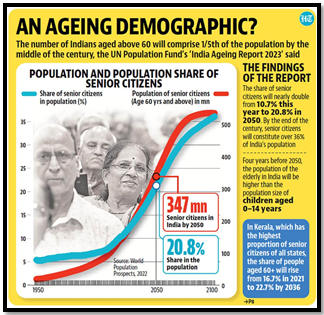ADDRESSING THE NEEDS OF AN AGEING INDIA”
Syllabus:
- GS-2- Social development, Welfare of Vulnerable sections , Ageing populations, Managing our Demographic dividend
Focus :
- The article highlights the challenges and needs of India’s ageing population, emphasizing significant gaps in access to pensions, health services, and social care. It underscores the importance of creating comprehensive policies to address these gaps and ensure the well-being and social security of older persons in India.
Source - IE
Introduction
- Public discourse in India focuses heavily on the youth bulge and the “demographic dividend.”
- Rising life expectancy is also causing India to age, necessitating increased focus on social security for older persons.
- The proportion of older persons in the population is expected to increase significantly by 2050.
- There are interstate variations in the ageing experience, with southern states and some northern states reporting higher elderly populations than the national average.
Rapid Ageing in Asia
Comparison with Western Countries
- East and South Asian societies are experiencing rapid ageing compared to Western countries.
- The increase in the proportion of older persons that took a hundred years in the West is happening in 20-30 years in South and East Asia.
- This rapid transition is challenging for middle and low-middle-income countries due to inadequate social protection.
Challenges Posed by Family Structure Changes
- Rapid changes in family structures, with a shift towards nuclear families, add to the challenge of caring for the elderly.
Policy Responses in East Asia
Integration of Health and Social Care
- East Asian countries have acknowledged the ageing reality and evolved policies to address it.
- They have integrated health and social care through financial investments, insurance schemes, and strengthened community-level institutions.
Lack of Similar Policies in India
- India does not have universal public pension schemes, health insurance, or comprehensive social-care provisioning.
- Some health insurance and social welfare schemes are targeted only at older persons below the poverty line.
- Macro data and micro studies highlight inequalities in the availability, accessibility, affordability, and acceptability of services for older persons.
Understanding the Needs of Older Persons
Demand-Side Analysis
- There is a need to understand older persons’ felt needs from the demand side.
- Assessing the supply side involves evaluating social protection, insurance schemes, and health and social-care institutions.
- Defining the ecosystem of care and offering a guide to policy planning is essential.
Social Determinants of Health and Well-being
- Geographical location, class, caste, gender, work, and pensions are important determinants of perceived quality of life.
- Many older persons, especially those in the unorganized sector, are ineligible for pension or other forms of income support.
Rural vs. Urban Experiences
Rural Areas
- The proportion of older persons is higher in rural areas compared to urban areas.
- It is assumed that rural elderly fare better due to family and community support.
Urban Areas
- Rapid urbanization and changes in family structure pose challenges for elderly care.
- Middle-class families can afford hired help for elderly care, but institutional support for long-term care is poorly developed.
Findings from Helpage India Report 2024
Financial Insecurity
- Gaps in access to financial security, health, and social care are highlighted.
- Social pensions are skewed towards the middle classes in government service, leading to financial insecurity among the elderly.
Limited Health Insurance Coverage
- Access to government health insurance like the Ayushman Bharat Programme is limited to those below the poverty line.
- Other government insurance programs cover only government employees and those in the organized sector.
- Difficulties in claiming insurance include long processing times, claim deductions, and rejections.
Health Challenges
Multiple Morbidities
- The burden of multiple morbidities due to Non-Communicable Diseases (NCDs) increases with age.
- Managing daily activities becomes challenging, necessitating physical and emotional support mostly provided by family members.
Caregiving Stress
- Changes in family structure in urban areas place caregiving stress on women in the household.
- In households with adult children who have migrated for work, older persons often live alone.
Institutional Support
- Institutional support for elderly care, such as retirement communities and long-term care, is underdeveloped.
- The upper-middle class and rich can access retirement communities with health and social-care services, but the lower-middle class and poor struggle.
| Government of India Initiatives –
1.National Social Assistance Programme (NSAP) Provides financial assistance to elderly citizens, widows, and disabled persons in the form of social pensions. Components:
2. Pradhan Mantri Vaya Vandana Yojana (PMVVY)
Features:
3. Rashtriya Vayoshri Yojana (RVY)
Features:
4.Ayushman Bharat – Pradhan Mantri Jan Arogya Yojana (AB-PMJAY)
Features:
|
Policy Recommendations
Addressing Inequalities
- Public policy must address multiple axes of inequalities in access to financial security, health, and social care.
- Significant gaps in access to pensions, health services, and social care need to be addressed as India becomes an ageing society.
- Focus on Healthy Ageing-Ensuring healthy ageing should be a priority alongside leveraging the “demographic dividend.”
Conclusion
- The challenges of an ageing population in India require comprehensive policy responses and integrated care systems.
- Addressing the needs of older persons through improved access to pensions, health services, and social care is crucial for their well-being and social security.
- Policymakers must focus on both the supply and demand sides to create an effective ecosystem of care for the elderly.
Mains UPSC Question
- “Discuss the challenges and policy gaps in addressing the needs of India’s ageing population. Evaluate the current social security measures and suggest ways to improve access to pensions, health services, and social care for the elderly.” (250 words)
Associated Article –
https://universalinstitutions.com/preparation-for-an-aging-population/




